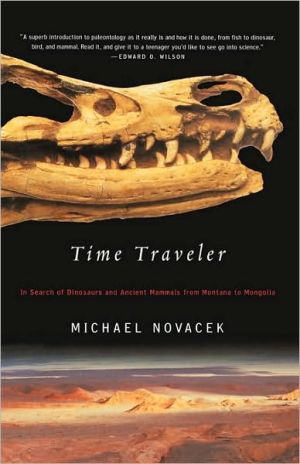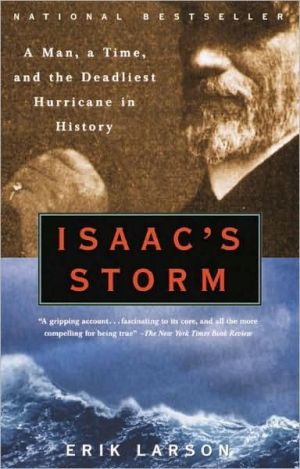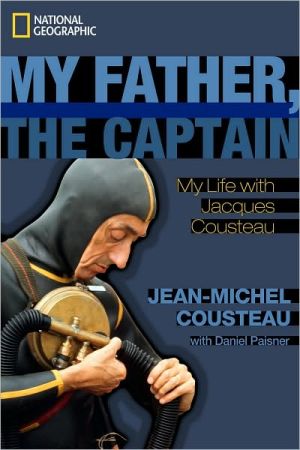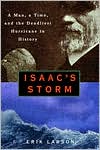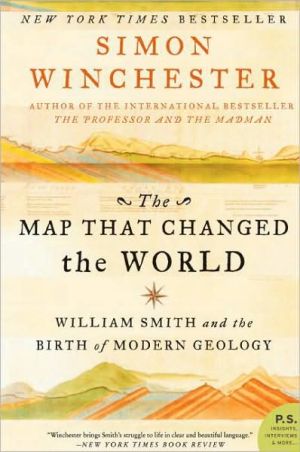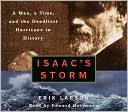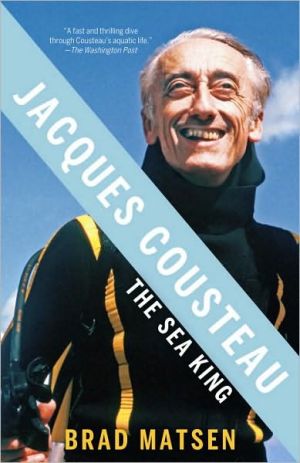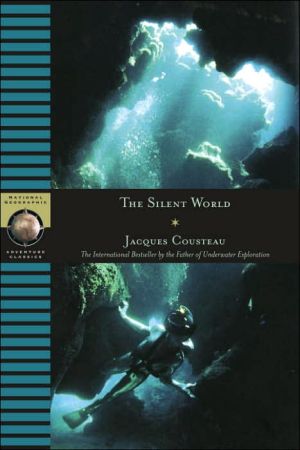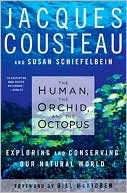Time Traveler: In Search of Dinosaurs and Other Fossils from Montana to Mongolia
“A superb introduction to paleontology as it really is and how it is done, from fish to dinosaur, bird, and mammal.” —Edward O. Wilson\ Michael Novacek, a renowned paleontologist who has discovered important fossils on virtually every continent, is an authority on patterns of evolution and on the relationships among extinct and extant organisms. Time Traveler is his captivating account of how his boyhood enthusiasm for dinosaurs became a lifelong commitment to vanguard science. Novacek...
Search in google:
“A superb introduction to paleontology as it really is and how it is done, from fish to dinosaur, bird, and mammal.” —Edward O. WilsonMichael Novacek, a renowned paleontologist who has discovered important fossils on virtually every continent, is an authority on patterns of evolution and on the relationships among extinct and extant organisms. Time Traveler is his captivating account of how his boyhood enthusiasm for dinosaurs became a lifelong commitment to vanguard science. Novacek writes of the alluring perils of fieldwork with affection and discernment, and he illuminates the most exciting issues in paleontology today. The New Yorker In 413 A.D., Saint Augustine wrote of the discovery of an enormous tooth on the Mediterranean shore: "If it were cut down into teeth such as we have, a hundred, I fancy, could have been made out of it." He went on: "For though the bodies of ordinary men were larger than ours, the giants surpassed all in stature." Fossil relics, Claudine Cohen points out in The Fate of the Mommoth newly translated from the French by William Rodarmor, were not infrequently taken as evidence of a prehistoric, super-tall human race. Elephant bones in particular spurred the imagination -- the hollowed nasal cavity in the skull of the now-extinct dwarf elephant was thought to be the eye socket of a Cyclops; the mammoth's ivory tusk, the spiralled horn of a unicorn. The myths persisted for centuries; when Lewis and Clark headed west, Thomas Jefferson expressed the hope that they would find a living woolly mammoth larger than those frozen in Europe, thus silencing the French naturalist Buffon, who wrote, "There is something in the New World that is contrary to Nature's growth." In Time Traveler, Michael Novacek, the curator of paleontology at the American Museum of Natural History, describes his own experience in hunting fossils as a sort of paleo-hazing of the new kids on the dig. Novacek points out the disdain of younger paleontologists for tracking big-game skeletons, and he offers illustrations of selected ancient creatures such as the feathered dinosaur Archaeopteryx and Smilodon californicus, the sabre-toothed tiger, slinking past the tar pits of Southern California. Novacek's adventures brought him close to his subjects: "I was lost in the rocks and lost in time."(Lauren Porcaro)
\ Time Traveler\ 1Dinosaur DreamerAs odd as it may seem, Los Angeles is a particularly good place to become a paleontologist. I didn't always appreciate this. Indeed, as a young boy I sometimes resented deeply an urban incubation that kept me from steady contact with nature. On rare days there were opportunities. When a hair-dryer wind from the desert blew the smog offshore, I would lope up to a hilltop street appropriately named Grandview. From that high place I could see the whole sweep of the basin, from the slate surface of the Pacific to the sinuous line of the San Gabriel Mountains. Without this cleansing wind, however, the view was depressingly predictable--a bristle of telephone poles and TV antennas that looked like charred trees rising in the haze.As an everyday experience in Los Angeles, real nature was something you saw on television. Cathode-tube cowboys raced against a backdrop of nature--always the same nature, a mass of sandstonesplintered into rocky slabs like planks on the deck of a scuttled ship. Many years later, on trips with college mates to the Mojave Desert, I learned that this location for TV and movie shoots, Vasquez Rocks, had been degraded to a roadside rest area off the freeway. Power lines, airplanes, and streams of cars could no longer be reliably excluded from the frame. As I explored this thoroughly humanized terrain, littered with cigarette butts and disposable diapers, I contemplated sadly my childhood fantasy that Vasquez Rocks was a place of mystery, maybe even a place where dinosaur bones were buried.In those early years, I hardly seemed cut out for bone hunting anyway. I was a skinny, spindly-armed boy, a kid with freckles, thick reddish brown hair, and a cowlick. The kind of kid who would stand earnestly by his lemonade stand on the sidewalk, more of a Beaver Cleaver type than a young Indiana Jones. I was not much of an athlete, and my nearsightedness required gigantic tortoiseshell glasses by the third grade. But I could run fast and far, climb pretty well, and balance decently on a narrow fence. I was not afraid of heights, but I hated closed-in spaces. I was not at all reluctant to be alone over stretches of time. There were other tendencies that prepared me for the life of a paleontologist. I liked crawling around in the dirt and mud, turning over rocks, and looking at things through binoculars and microscopes. I liked books, ones on dinosaurs of course, but books on just about anything--chemistry, astronomy, mountaineering, biographies, fiction, Mark Twain, Jules Verne, H. G. Wells, Robert Louis Stevenson, Charles Dickens, Alexander Dumas, Superman, Batman.When I was ten, I was not quite old enough for the parental ban to be lifted on viewing the classic 1933 film King Kong. After all, it was rather improper for a youth to witness a hundred-ton gorilla carry a young woman in shredded clothing around in his hairy hand. But one night, after endless and annoying entreaty, I got special permission to watch King Kong on television. Mom, who was watching with me, apparently dozed off, and so did I. I heard a dull thud when my dad set his guitar case down on the burnt orange carpet. He had a late-night music job. It must have been at least two in the morning. At my father's command, I staggered off tothe small bedroom where my brother and I shared bunk beds. I crawled up to the top bunk and lay there thinking about the movie. I tried to reconstruct my favorite scene--King Kong meets Tyrannosaurus rex near a giant log wedged between the edges of a deep, fern-stuffed chasm in the jungle. I replayed the scene in my mind several times, with variations. King Kong, as per the movie, vanquishes Tyrannosaurus. King Kong and Tyrannosaurus are entangled in a death plunge to the canyon floor. King Kong and the dinosaur, exhausted, drift away from each other to their respective corners of the ring. Even more gory PG-13 variations came to mind--the tyrant king disembowels the gorilla with a single slash of its scimitar teeth ...I could hear Dad laughing and softly talking to Mom. "Shirl, you should've heard that bass player tonight. Wow, he could play everything." Dad played jazz and those classic tunes by Rodgers and Hart, Billy Strayhorn, and others. He could also sing them spectacularly well. Only in later years did I really come to appreciate the singer and the songs. On this night, as on many others, I pulled out my transistor radio from the cleft where the bunk met the wall. The radio had a brittle plastic shell and some gouge marks for its ill-fitting screws that I'd made when I struggled to build the radio from a kit one Christmas Day. In the soft light from outside my bedroom, I could barely make out the words "Made In Japan." I turned the knob of the crude analog tuner as the radio popped and whined like the control panel in Flash Gordon's rocket ship. To my great delight, I captured the weak signal of Elvis's "Jailhouse Rock."That night I had a variation of a recurring dream. I was walking on a red sandy hill, swinging a rock pick. An army canteen hung from my belt. I wore a wide-brimmed hat, like those of scientist-explorers in books on paleontology or even in King Kong. As I climbed the hill, a magnificent skeleton of a familiar carnivorous dinosaur stretched out on the ground below me. The skeleton was not completely exposed. I could see the tip of the snout and the rapiers of its front teeth reflecting in the sun. Amazingly, a couple of feet away, the brow of the eye socket--part of the same skull--was poking through the sand. Farther down were the small claws of a ridiculously tiny forelimb. A few other parts of the skeleton wereexposed--a shoulder blade, some vertebrae, the stout upper leg bone, and a giant claw on the three-toed hind foot. The tail vertebrae extended a long way on the top of the hill, burrowed into the ground like a sand snake, and then emerged seven feet farther down the slope, the few tiny bones at the tip of the tail not much bigger than some of the wooden spools in my Tinkertoy box. It was all there. Every bone, process, and articulation was spread out before me, from the small openings of the nasal passages to the tip of the caudal vertebrae (like other intense dinophiles of ten, I knew many of the technical terms for dinosaur bones). I knelt down near the skull and started carefully cleaning the surface of the bone with a soft, broad paintbrush, like those in the turpentine can in our garage. As I worked, I felt alone in the world. The desert was motionless, devoid of living, breathing things, only a place where a line of red sand met the sky. There was no wind, only the low hum of the engine that pumps blood through your inner ear. Soon, though, I began to feel the intrusion of a shadow at my back. I turned around and was transfixed as a giant cumulus cloud coalesced into the form of Tyrannosaurus rex. \ At the time I first learned about them, dinosaurs were believed to have been sluggish, dumb reptilian creatures. Their relationships with living groups were vague, though crocodiles and lizards at least provided some inspiration for what dinosaurs must have been like. Indeed, many science-fiction filmmakers recruited lizards and attached horns or spikes to them when they wanted live-action dinosaurs. They then filmed the embellished lizards attacking other lizards or even cavemen. Even as a kid I knew the juxtaposition of these faux dinosaurs with humans was absurd--humans after all appeared on the earth 60 million years after the big dinos went extinct. But in the late 1950s, neither I nor paleontological experts knew many things that we know today. For one thing, we didn't know that some dinosaurs indeed survived that massive extinction event at the end of the Cretaceous period, the last chapter in the age of the dinosaurs. The survivors were of course birds. We have strong evidence that birds likely evolved from a subgroup of dinosaurs including active, predaceous, and probably very intelligent forms like Tyrannosaurus and Velociraptor. Today a few scientists still object to this connection between birds and dinosaurs, but they do so in denial of a mass of accumulating paleontological data. This includes newly discovered fossils from China that show that nonflying dinosaurs much like Velociraptor had feathers!As with many other young lives, mine was devoted to desperately re-creating--through dreams and mini-expeditions--a landscape that erased the banal ambience of my "hometown." When we think of nature, we may think of a magnificent African savanna populated with lions, giraffes, and herds of elephants. But what is nature to a kid in Los Angeles? To me it was a rather limited list of creatures: an overturned potato bug with its half-dozen legs desperately flailing to find hard ground, an alligator lizard popping out when lifted by its shedding tail, some fat tadpoles in a garden pond, a tiger swallowtail butterfly flickering yellow and black in the geraniums, a pill bug, an ant colony, a rat in a palm tree.A neighborhood encounter with dinosaur bones or other fossils was of course essentially impossible. This experience would require some imagination. For me, a vacant, weed-choked lot became a fossil-strewn desert with endless prospects. One such area was a spitof eroded sand and gravel that divided a broad street a few blocks from my house. Crossing this escarpment one day I saw a string of fragmented concrete blocks that looked for all the world like the vertebral column of a long-necked sauropod dinosaur. I recruited a group of friends, including my rather forcefully conscripted younger brother, to excavate this monster. Our make-believe work on "Dinosaur Island" was my first field expedition.I read about real field expeditions, especially ones that brought bone hunters to the canyonlands of Montana and Wyoming or the empty, windswept deserts of Mongolia in Central Asia. I knew with satisfaction that there were even great excavations and discoveries within the city limits. The very center of the L.A. Basin--its lowest part--is a jumble of upscale department stores and high-rise apartments along Wilshire Boulevard's "Miracle Mile." The only nature in this agglomeration is a poorly manicured park of tawny grass and dusky oak trees, where in places small pools with an unctuous film of slow-moving water covers the stews of bubbling tar. The tar gives the park its Spanish name, La Brea (although the sticky substance in the pools is actually asphalt, a mixture of different forms of tar and sand). Thousands of years ago, huge numbers of mammals, birds, lizards, frogs, and other creatures congregated around these pools for water. A great many of them fell in and died trying to struggle out. This accumulated carnage makes for one of the world's richest and most remarkable fossil sites.I went to Rancho La Brea Park as often as possible with my parents to watch history in the making. I stared at those pools, waiting for some hapless squirrel or sparrow to go too close and get stuck fast. It takes many hours or even days to witness such tragedies--indeed I don't think I ever saw any--but the evidence for mortality was abundant. It was a thrill to see a feather sticking out of the tar like a quill pen in an inkwell, or the leg bone of a rabbit picked clean by a predatory bird all the way to the tuft of dandelionlike hair around the tough, inedible foot. Death did not seem in any way dark or frightening; it seemed an inevitable conclusion whose circumstances left fascinating evidence of an earlier life. I even made a fleeting discovery that there was a La Brea in my own neighborhood. Romping through a broad swamp destined to bereclaimed as a golf course, my friends and I spotted some black, viscous ooze with that familiar rainbow sheen lazily swirling around the stalks of high grass and bamboo. "It's a tar pit!" we shouted. Moments later we were bitterly disappointed to find nearby a pile of ulcerating oil drums. \ My favorite features at Rancho La Brea Park were some life-sized statues of saber-toothed tigers and imperial mammoths. These creatures of course no longer lived in the L.A. Basin and their bones were not visible on the surface of any of the pools. However, a stupendous array of tar-stained black bones of such animals filled the halls of the Los Angeles County Natural History Museum, some ten miles away. These were the remnants of an ancient and populous community of big mammals. They were an odd bunch, a combination of the bizarre with the familiar--cat skeletons as big as bear skeletons, and elephantine skulls that looked like helmets of ancient Greek warriors, only with tusks that extended so far they curled back on themselves and crossed each other.Above these mounts was a mural by the great painter of prehistory, Charles R. Knight. This is La Brea 12,000 years ago. The setting is all southern California. The stage is a burnished field of grass, the kind that becomes a tinderbox in the dry canyons of the Santa Monica Mountains on those hot September days. A few writhing, leafless oaks are rooted in the grass around the black tar pools. The backdrop is the distant deep blue of a mountain range, the same profile of peaks I could see from Grandview Boulevard--after all, mountains don't appreciably change in 12,000 years unless a volcano punctures them or an earthquake breaks them down. Perched on a surly gray oak are a gang of crook-necked giant vultures peering down on their mates feeding on a bulky carcass. The vultures look odd and out of scale on that tree, as indeed they should: with wingspans of nearly thirteen feet, they are about one-fourth larger than their living and highly endangered relative, the California condor. The foreground of this panorama is dominated by two different and famous La Brea species. At left center, a saber-toothed cat in full profile is in a stalking mode, its jaws at open gape, yawning, displaying its absurdly elongate upper canines. At dead center are a cluster of zombielike giant ground sloths. The biggest of these is standing high on its hind limbs, its neck stretched, its nose up, like a grizzly bear sniffing the air for intruders. Flanking this center-stage group is a cohort of dire wolves; their heads poke up through the tall grass ready to pounce and to dine. To the right, a bit farther back, a herd of camels stroll slowly into view, humpless, short-necked, barrel-chested, pigeon-toed. Behind the camels some stocky black-legged horses kick up the dust. As if not to overshadow this bestiary, the huge imperial mammoths, some fifteen feet high at the shoulder, can be seen in the far distance in a clearing among the oaks and below the blue mountains.They are all dead, gone, extinct. There are no more imperial mammoths, dire wolves, La Brea camels, saber-toothed cats, and giant ground sloths. Not even those horses linger on. Horses native to North America went extinct around La Brea time; the horses that ran wild in the West or were mounted by Indians were import models, brought in by Spanish conquistadors and other explorers. Charles Knight's vision of life in Los Angeles 12,000 years ago was grander than the African savanna. I was struck by the fact that Los Angeles a few thousand years ago had bigger, more awesome animals than any place on earth today.The La Brea Tar Pits and the fossils embedded in them were, to me, a miraculous gift to Los Angeles. In Catholic school, a nun who had visited Lourdes regaled us with tales of the astounding cures that came to pilgrims who partook of the holy waters there. But Lourdes did not seem at all interesting to me. Even at the ageof ten, I had developed a skepticism for the mystical and the unexplainable. La Brea was both fantastic and real; religious lore could not compete with its vivid evidence. My predilection for empiricism was not always rewarded. The same nun who waxed poetic about Lourdes had divided our fourth-grade class into three sections according to a scale of perceived intelligence and acceptability. The west two rows were the "Dummies," the east two rows, the "Smarties," and the middle purgatorial row, wherein I held a place of dubious honor, the "Spacemen." I tried to transport myself out of that miserable place as often as possible, usually by concealing my favorite science book behind a catechism for a surreptitious read. One day I savored the diorama painting of Ice Age mammals in the large, not so easily concealed Time-Life book The World We Live In. The nun swooped down on me and rapped my hands. "There you are once again reading about monsters!" she shouted as she threw the book to the floor and gave it a permanent stamp with her dainty little shoe. I was held after school, but I got the book back. Later that afternoon I sat on the porch at home reading the forbidden World We Live In and sipping lemonade. I daydreamed about a Los Angeles lost in time with its ground sloths, mammoths, and saber-toothed cats. I extended the dreamscape beyond my hometown to the Montana badlands where Tyrannosaurus took rest and to the empty red deserts of Central Asia where the first dinosaur nests, and the first complete skeletons of primitive shrewlike mammals (presumably the marauders of dinosaur nests), had been discovered. I dreamed of all the continents, canyons, and quarries still waiting to be plundered for fossils. It was good to be a "Spaceman."Copyright © 2002 by Michael Novacek
1.Dinosaur Dreamer32.The Canyon of Time123.Early Expeditions254.The Plateau of the Dragons355.The Rookies516.Journey of Death577.The Paleontological Chain Gang668.Red Rocks829.Back to the Bones8910.The Pits9511.The Age of Mammals Revisited10412.Road Cuts and Fossil Vermin11313.Badlands, Bones, and Bone Hunters12314.Hell Creek Is for Dinosaurs13615.The Curious Beasts of Old Baja15216.Baking Below the Buttes16417.Whales on Mountaintops18218.A Man and His Horse19619.Pampa Castillo21120.Bone Hunters in Patagonia22421.Above the Clouds and the Condors23422.The Land of Sheba25023.To the Foot of the Flaming Cliffs27824.The Cretaceous Cornucopia29325.Last Chance Canyon314Acknowledgments323Notes327Selected Reading List351Index355Illustration Credits367
\ From Barnes & NobleCurator of paleontology at the American Museum of Natural History, Michael Novacek has lived his whole life hunting fossils. Filled with discoveries about dinosaurs and other ancient creatures, this personal account gives an intimate portrait of a life in the field -- the excitement as well as the frustrations -- from Novacek's childhood in Los Angeles to expeditions to the far-flung corners of the world.\ \ \ \ \ From the Publisher\ “[Novacek is] a world-class field scientist. He’s also one of paleontology’s most effective popularizers, a highly entertaining writer who is just as good at bringing oviraptors, glyptodonts, and other fantastic creatures to life in print as he is at spotting their fragmented remains in a wall of rock.” —Jennifer Schuessler, The American Scholar\ “An engaging book . . . [Novacek] gives us an excellent sense of the way paleontologists have arrived at their world-shaking conclusions . . . With good humor and generosity . . . he offers genuine insights into the kind of reasoning that has allowed us to know so much about past eras, and he conveys a lively picture of his professional experiences.” —David Papineau, The New York Times Book Review\ \ \ \ \ The New YorkerIn 413 A.D., Saint Augustine wrote of the discovery of an enormous tooth on the Mediterranean shore: "If it were cut down into teeth such as we have, a hundred, I fancy, could have been made out of it." He went on: "For though the bodies of ordinary men were larger than ours, the giants surpassed all in stature." Fossil relics, Claudine Cohen points out in The Fate of the Mommoth newly translated from the French by William Rodarmor, were not infrequently taken as evidence of a prehistoric, super-tall human race. Elephant bones in particular spurred the imagination -- the hollowed nasal cavity in the skull of the now-extinct dwarf elephant was thought to be the eye socket of a Cyclops; the mammoth's ivory tusk, the spiralled horn of a unicorn. The myths persisted for centuries; when Lewis and Clark headed west, Thomas Jefferson expressed the hope that they would find a living woolly mammoth larger than those frozen in Europe, thus silencing the French naturalist Buffon, who wrote, "There is something in the New World that is contrary to Nature's growth."\ \ \ In Time Traveler, Michael Novacek, the curator of paleontology at the American Museum of Natural History, describes his own experience in hunting fossils as a sort of paleo-hazing of the new kids on the dig. Novacek points out the disdain of younger paleontologists for tracking big-game skeletons, and he offers illustrations of selected ancient creatures such as the feathered dinosaur Archaeopteryx and Smilodon californicus, the sabre-toothed tiger, slinking past the tar pits of Southern California. Novacek's adventures brought him close to his subjects: "I was lost in the rocks and lost in time."(Lauren Porcaro)\ \ \ \ \ \ Publishers WeeklyTransporting readers to dinosaur excavations across the globe, paleontologist Novacek (Dinosaurs of the Flaming Cliffs) offers a spellbinding natural history of our planet, as well as the equally fascinating story of how he fell into the profession. As a child, Novacek mined for bones in the backyards of Los Angeles, studied the geostrata of the Grand Canyon, discovered a trilobite fossil in a Wisconsin quarry and frequently visited the local La Brea Tar Pits. Though Novacek claims he's no Indiana Jones, he finds himself on the wrong side of a gun more than once whether the gun be held by Mexican drunkards or the Yemeni army. The most rousing passages depict stormy expeditions to Chilean Patagonia in search of fossilized whale vertebrae along an ancient shoreline in the Andes an incredible 10,000 feet above sea level. Novacek's team also discovered rare dinosaur trackways that today appear to scale the vertical walls of deep canyons, and the team accomplished what Charles Darwin set out to do 150 years earlier they collected fossils of giant sloths, armadillos and the peculiar glyptodonts for the study of mammalian vertebrae. Novacek mixes heady science his explanations of Carbon-14 dating, geological development, ancient magnetic forces and paleontological history are clear and dynamic with hard-grit adventure, making for a passionate memoir that readers will find appealing, especially, perhaps, young "dinophiles" in search of a vocation. Illus. (Feb.) Copyright 2001 Cahners Business Information.\ \ \ \ \ Library JournalIs paleontology important today? This is the question noted paleontologist and American Museum of Natural History curator Novacek poses in his latest book. His experiences in the field support the conclusion that the fossil record provides us with important information related to our evolutionary future and, more significantly, reveals facts related to various mass extinctions in the past. The fossil record also reveals patterns in extinction; recently, a scientific paper put forth the possibility that it may take as long as ten million years to replenish the earth's ecosystems following a mass extinction. Those sobering comments aside, most of Novacek's book reads like an Indiana Jones movie script. His fieldwork has taken him to some of the most politically unstable and dangerous places in the world Yemen, Patagonia, Mongolia which hold some of the most important fossil finds relating to the evolution of mammals and how dinosaurs lived, died, reproduced, and cared for their young. Even routine field trips to Baja and Hell Creek are fraught with hazards relating to extreme temperatures and mishaps with horses and insects. Recommended for public libraries and armchair adventurers everywhere. Gloria Maxwell, Penn Valley Community Coll., Kansas City, MO Copyright 2001 Cahners Business Information.\ \ \ \ \ From The CriticsPaleontologist Novacek (American Museum of Natural History, New York) again proves himself to be an appealing writer with a reflective and accessible style. In this blend of memoir, adventure story, and science reporting, he talks about his own beginnings as a "dinosaur dreamer" during childhood in Los Angeles. He then covers political battles that shaped various expeditions across the globe; the pressing issues of paleontology; concepts like evolution, continental drift, mass extinctions, and scientific method; and the tediums and thrills of life in the field. He is also the author of (1996). Annotation c. Book News, Inc., Portland, OR (booknews.com)\ \ \ \ \ Kirkus ReviewsEntertaining snapshots of the author's worldwide journeys in search of bones, rocks, and all that other stuff of the dinosaur business. Growing up within shouting distance of Los Angeles's La Brea tar pits, Novacek (Dinosaurs of the Flaming Cliffs, 1996), now curator of paleontology at the American Museum of Natural History, got bitten early by the dinosaur bug. In the late '60s, rather than follow the other members of his rock band to Woodstock, he signed on to a fossil-finding expedition with UCLA zoologist Peter Vaughn, who had jumped from the Permian to the Pennsylvanian eras (a hop of more than a hundred million years) to track down some "really neat" amphibians. This exercise in "time tripping" was all it took to hook Novacek, who himself had found a few really neat fossils on family vacations in Wisconsin and the Grand Canyon. Subsequently employed by various colleges and then the AMNH, he has spent the last four decades wandering in and out of such places as Yemen, Tierra del Fuego, and the Gobi Desert, hunting for the sometimes big, sometimes scary life forms of the distant past. Armchair travelers will enjoy Novacek's account of such venues, while would-be paleontologists will benefit from his picture of how fieldwork is conducted, breezily unfolded across a span of many anecdotes about expedition-mounting in unpredictable circumstances amid perils that range from runaway trucks on Mexican cliff faces to rabid Arabian dogs and dancing Chilean belles. For Novacek, though, any difficulties have been offset by his profession's payoffs, which include both advancing science and allowing him "to see extraordinary places and people in a world that, even during my few decades of fieldexploration, has become less exotic and more intimately entwined." A real pleasure for dinosaur buffs.\ \
